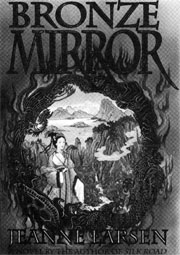Bronze Mirror
By Jeanne Larsen.
Henry Holt: New York, 1991.
337 pp. $19.95.
To our shame, Western culture as a whole still hasn’t learned how to make pre-modern Chinese literature a comfortable part of its artistic experience. The language is too different from our own, and we professors as a group are admittedly too stodgy to seek the golden key that will make its greatness known to the nonspecialist. Instead, the curious Westerner usually turns to the modern historical novel and takes it for truth, always hoping that the writer’s world is “real,” that it reveals to us life as it was in ancient or medieval China. Such novels are read as easy introductions to a culture that might be too difficult to comprehend through translations of its own literature. Yet the attitudes that result often create merely an increase of confusion and prejudice.
Jeanne Larsen’s novels avoid this problem, because as a student of Chinese literature and a talented translator of Chinese poetry, she approaches the novelist’s task immersed already in the traditions and themes of classical Chinese literature. Her first novel, Silk Road, was an imaginative, personal vision of the life of a T’ang dynasty (eighth-century) courtesan turned knight-errant. It sounded authentic, because Larsen depended on the Chinese literary tradition itself for her plot and character depictions. The result was a sort of revisionist pop fantasy that wore its erudition lightly.
Bronze Mirror, Larsen’s second work, is much the same, though less heroic and fantastic in tone. Set in the beginning of the southern Sung dynasty (early twelfth century), it details the decline of a petty gentry family told through the eyes of one of its maidservants. As with Silk Road, Larsen complicates the texture of the novel by telling her story from various points of view, particularly that of the supernatural: behind the “realistic” events of the family’s decline are a host of traditional Chinese deities—Taoist and Buddhist—who “write out” the characters’ lives and who are themselves subject to sexual and auctorial jealousies that affect the destinies of the mortals. Linking the two realms is the bronze mirror the title—a Han dynasty artifact in the possession of Phoenix, the young wife of the oldest son. Larsen knows well the abundance of traditional Chinese and Buddhist lore surrounding mirrors as a symbol of illusion, or, at times, the mind; their capacity to become windows onto other worlds; and their talent in revealing the truths of the human heart.
To tell more of the plot of Bronze Mirror is to reveal too much. It is simplicity itself. In fact, it is little more than an excuse for Larsen’s literary acrobatics, as she shuttles between human and spirit worlds and twists the story into a myriad of different perspectives. Particularly amusing and skillful is her ability to mimic or parody Chinese fiction. At various points, the Western-style narrative is retold in the language of traditional accounts about the strange and supernatural. This playful toying with the novel’s core may remind contemporary readers of the techniques of magic realism, but Larsen’s roots here are more authentic: her direct influences in many cases are Journey to the West, T’ang short fiction, and The Story of the Stone.

Still, there are a few things I find disturbing in Larsen’s book. For example, her massive borrowings from Chinese literature—admittedly one of the book’s great strengths in the authenticity line—makes it appear to the reader unfamiliar with the tradition that she is much more creative and imaginative than she really is. I played “spot the source” on almost every page of Bronze Mirror, until I decided that the author’s ability lay mostly in being able to steal the right motif at the right time. Of course, the Chinese tradition itself has not overvalued originality and has been addicted to constant retellings of its favorite stories, but Larsen ought to depend less on the tradition or at least let us know the full extent of her debt.
Another problem with Bronze Mirror, paradoxically, is that it is still a creature of its own time, in spite of Larsen’s dependence on Chinese literature. As such, it is preoccupied with the issues of the Nineties, especially feminism. This, of course, is far from being a problem in and of itself. It has led Larsen to a wonderful re-creation of the world of women in a society that was brutally and assertively male. But the characters often show an awareness of the issues behind sexuality in ways that are too present-day American. The suppression of female authorship; the skewing of morality in ways that keep women in an inferior position; the strategies that women use to assert independence within their own world—these are certainly legitimate topics for any investigaror of premodern Chinese society, but the Chinese would not have stated the issues in these terms. When Larsen places discussions of sexual politics in the mouths of her mortals—and immortals—the result is often coy and jarring.
Nevertheless, Larsen shows a real gusto in telling us the detail of Sung dynasty life, and her scholarship is deep without ever seeming pretentious. No one can say, of course, that her vision of Sung China is exact, but with reservations, it’s certainly very plausible—and that’s the best anyone can hope for. Like Silk Road, Bronze Mirror is a pretty good read—well-written, with enough knowledge to be entertainingly instructive to the curious.